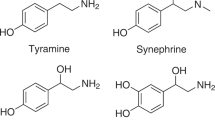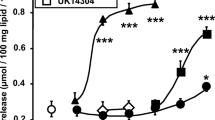Summary
Although the selective monoamine oxidase (MAO) inhibitor, (−)-deprenyl, substantially inhibits tyramine-oxidizing ability in the pig, intravenous tyramine challenge after pretreatment with this drug failed to produce the characteristic pressor response (“cheese effect”) associated with other irreversible MAO inhibitors. Conversely, pretreatment with the tyramine oxidation-sparing selective MAO inhibitor, clorgyline, followed by intravenous tyramine, paradoxically resulted in a profound pressor response. We suggest that the action of standard MAO-inhibiting drugs may be compounded of two separate actions, usually associated but, in fact, unrelated.
Similar content being viewed by others
References
Brown, G. L., Gillespie, J. S. The output of sympathetic transmitter from the spleen of the cat. J. Physiol. (Lond.)138, 81–102 (1957).
Egashira, T., Ekstedt, B., Oreland, L. Inhibition of clorgyline and deprenyl of the different forms of monoamine oxidase in rat liver mitochondria. Biochem. Pharmacol.25, 2583–2586 (1976).
Ekstedt, B., Oreland, L. Heterogeneity of pig liver and pig brain mitochondrial monoamine oxidase. Arch. Int. Pharmacodyn.222, 157–165 (1976).
Elsworth, J. D., Glover, V., Reynolds, G. P., Sandler, M., Lees, A. J., Phuapradit, P., Shaw, K. M., Kumar, P. Deprenyl administration in man: a selective monoamine oxidase B inhibitor without the “cheese effect”. Psychopharmacology57, 33–38 (1978).
Holt, M. C. Pargyline hydrochloride in essential hypertension. Br. J. clin. Pract.21, 447–453 (1967).
Iversen, L. L. The Uptake and Storage of Noradrenaline in Sympathetic Nerves. Cambridge: Cambridge University Press. 1967.
Johnston, J. P. Some observations upon a new inhibitor of monoamine oxidase. Biochem. Pharmac.17, 1285–1297 (1968).
Knoll, J. Analysis of the pharmacological effects of selective monoamine oxidase inhibitors. In: Monoamine Oxidase and its Inhibition (Wolstenholme, G. E. W., Knight, J., eds.), pp. 135–161. Amsterdam: Elsevier Excerpta Medica-North Holland. 1976.
Knoll, J., Magyar, K. Some puzzling pharmacological effects of monoamine oxidase inhibitors. In: Monoamine Oxidases-New Vistas (Costa, E., Sandler, M., eds.), pp. 393–408. New York: Raven Press. 1972.
Lader, M. H., Sakalin, G., Tansella, M. Interactions between sympathomimetic amines and a new monoamine oxidase inhibitor. Psychopharmacologia18, 117–123 (1970).
Lee, K. Y., Beilin, L. J., Vandongen, R. Severe hypertension after ingestion of an appetite suppressant (phenylpropanolamine) with indomethacin. Lanceti, 1110–1111 (1979).
Lipper, S., Murphy, D. L., Slater, S., Buchsbaum, M. S. Comparative behavioral effects of clorgyline and pargyline. Psychopharmacology62, 123–128 (1979).
Lowry, O. H., Rosebrough, N. J., Farr, A. L., Randall, R. J. Protein determinations with the Folin phenol reagent. J. biol. Chem.193, 265–275 (1951).
Marley, E. Monoamine oxidase inhibitors and drug interactions. In: Drug Interactions (Grahame-Smith, D. G., ed.), pp. 171–194. London: Macmillan. 1977.
Mendis, N., Pare, C. M. B., Sandler, M., Glover, V., Stern, G. M.: Submitted for publication (1980).
Pickar, D., Cohen, R. M., Jimerson, D. C., Murphy, D. L.: Selective MAO A and MAO B inhibition and intravenous tyramine pressor sensitivity. Poster Session, 18th Annual Meeting, American College of Neuropsychopharmacology, San Juan, 1979.
Robinson, D. S., Lovenberg, W., Keiser, G., Sjoerdsma, A. Effects of drugs on human blood platelet and plasma amine oxidase activityin vitro andin vivo. Biochem. Pharmac.17, 109–119 (1968).
Robinson, D. S., Nies, A., Ravaris, C. L., Lamborn, K. R. The monoamine oxidase inhibitor, phenelzine, in the treatment of depressive anxiety states. A controlled clinical trial. Arch. Gen. Psychiat.29, 407–413 (1973).
Simpson, L. L. Evidence that deprenyl, a type B monoamine oxidase inhibitor, is anindirectly acting sympathomimetic amine. Biochem. Pharmacol.27, 1591–1595 (1978).
Smith, C. K., Durack, D. T. Isoniazid and reaction to cheese. Ann. Int. Med.88, 520–521 (1978).
Squires, R. F. Multiple forms of monoamine oxidase in intact mitochondria as characterized by selective inhibitors and thermal stability: a comparison of eight mammalian species. In: Monoamine Oxidases-New Vistas (Costa, E., Sandler, M., eds.), pp. 355–370. New York: Raven Press. 1972.
Author information
Authors and Affiliations
Rights and permissions
About this article
Cite this article
Sandler, M., Glover, V., Ashford, A. et al. The inhibition of tyramine oxidation and the tyramine hypertensive response (“cheese effect”) may be independent phenomena. J. Neural Transmission 48, 241–247 (1980). https://doi.org/10.1007/BF01250659
Received:
Issue Date:
DOI: https://doi.org/10.1007/BF01250659




